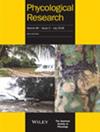First record of Neoporphyra haitanensis (T.J.Chang & B.F.Zheng) J.Brodie & L.‐E.Yang (Bangiales, Rhodophyta) from Shikinejima Island and Hachijojima Island of the Izu Islands, southern central Japan
IF 1
4区 生物学
Q2 MARINE & FRESHWATER BIOLOGY
引用次数: 5
Abstract
We conducted a morphological observation and molecular phylogenetic analyses on bladed Bangiales collected from natural populations on Shikinejima Island and Hachijojima Island of the Izu Islands, southern central Japan. The morphological features of the gametophytic blades such as the blade shape, blade margin and reproductive cell divisions were extremely similar to those parameters of Neoporphyra haitanensis, a species cultivated in southern China, and Neoporphyra dentata. However, the blades collected from the two islands were thicker than the blades of N. dentata; this feature was the same as that of N. haitanensis. The chloroplast RUBISCO spacer sequences of present samples were identical to the sequences of N. haitanensis from China. Moreover, phylogenetic positions of three conchocelis strains isolated from the blades on the two islands were examined based on concatenated sequences of the chloroplast rbcL gene and nuclear 18S rRNA. The results showed that the strains were resolved in a clade including N. haitanensis; however, the strains were separated from N. haitanensis in China. Therefore, the bladed Bangiales from the two islands were identified as N. haitanensis. The present study is the first record of N. haitanensis in natural populations in Japan.日本中南部伊豆列岛岛和八重岛的坛新豚(T.J.Chang&B.F.Zheng)J.Brodie&L.‐E.Yang(Bangiales,Rhodophyta)的首次记录
对日本中南部伊豆群岛石岛和八丈岛自然种群中采集的有叶虎进行了形态观察和分子系统发育分析。配子体叶片的叶片形状、叶缘、生殖细胞分裂等形态特征与中国南方的海棠新叶卟(Neoporphyra haitanensis)和齿状新叶卟(Neoporphyra dentata)极为相似。然而,从两个岛屿采集的叶片比齿齿蕨的叶片厚;这一特征与海棠相同。本研究样品的叶绿体RUBISCO间隔序列与中国海地稻的序列相同。此外,根据叶绿体rbcL基因和细胞核18S rRNA序列的连接,对从两个岛屿叶片中分离的3株螺虫进行了系统发育定位。结果表明,这些菌株在包括海地奈瑟菌在内的一个分支中分离;然而,这些菌株是从中国的海坦乳杆菌中分离出来的。因此,这两个岛屿上的有叶孟加拉虎被鉴定为海地亚种。本研究是首次在日本的自然种群中记录到海坦白蚁。
本文章由计算机程序翻译,如有差异,请以英文原文为准。
求助全文
约1分钟内获得全文
求助全文
来源期刊

Phycological Research
生物-海洋与淡水生物学
CiteScore
3.60
自引率
13.30%
发文量
33
审稿时长
>12 weeks
期刊介绍:
Phycological Research is published by the Japanese Society of Phycology and complements the Japanese Journal of Phycology. The Journal publishes international, basic or applied, peer-reviewed research dealing with all aspects of phycology including ecology, taxonomy and phylogeny, evolution, genetics, molecular biology, biochemistry, cell biology, morphology, physiology, new techniques to facilitate the international exchange of results. All articles are peer-reviewed by at least two researchers expert in the filed of the submitted paper. Phycological Research has been credited by the International Association for Plant Taxonomy for the purpose of registration of new non-vascular plant names (including fossils).
 求助内容:
求助内容: 应助结果提醒方式:
应助结果提醒方式:


